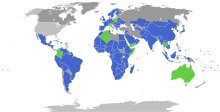Nagoya Protocol
The Nagoya Protocol (English Nagoya Protocol on Access to Genetic Resources and the Fair and Equitable Sharing of Benefits Arising from Their Utilization ) is an international environmental agreement adopted on October 29, 2010 in Nagoya at the 10th Conference of the Parties to the UN Biodiversity Convention to implement the Goals of the UN Convention on Biological Diversity (CBD) of 1993 (" Aichi goals "). After 50 states and the EU ratified the protocol on July 14, 2014, it came into force 90 days later on October 12, 2014.
content
The Nagoya Protocol creates a framework under international law for access to genetic resources and fair sharing of benefits . On the basis of mutual consent, a balance should be made between the different interests of the countries of origin of genetic resources and those countries in which the genetic resources are used. Above all, the biopiracy denounced by developing countries should be contained in this way.
Emerging and developing countries had long campaigned for a solution of benefit sharing that was binding under international law. Brazil in particular was one of the driving forces behind the negotiation process. Until the last night of the biodiversity conference, it was not clear whether the Nagoya Protocol would really be adopted. The negotiations were brought to a successful conclusion thanks to the energetic leadership of the Japanese Environment Minister Ryū Matsumoto , who on the last day of the negotiations, in his authority as conference chairman, presented a comprehensive proposal for a compromise on all outstanding contractual provisions. This proposal was initially politically accepted by all the ministers present in a closed session and was later formally adopted by the final plenary of the Conference of the Parties.
Come into effect
In accordance with Article 32 of the Protocol, it was open for signature at the United Nations in New York from February 2, 2011 to February 1, 2012 , and could also be signed after this period had expired. The protocol entered into force on October 12, 2014, the 90th day after the 50th instrument of ratification was deposited with the United Nations. The European Commission is currently working on a proposal for the implementation of the protocol in European law, on the basis of which it is also to be ratified.
Web links
- Information on the protocol , Convention on Biological Diversity
Individual evidence
- ↑ International Institute for Sustainable Development: Summary of the Tenth Conference of the Parties to the Convention on Biological Diversity: October 18-29, 2010 from November 1, 2010 (PDF; 2.8 MB)
- ↑ UNEP: Nagoya Protocol on genetic resources and associated traditional knowledge comes into effect today , press release of October 12, 2014.
- ↑ Convention on Biological Diversity: A new era of living in harmony with Nature is born at the Nagoya Biodiversity Summit (PDF; 167 kB), press release from October 29, 2010
- ↑ Japan Times of October 31, 2010 [1]
- ↑ Buck and Hamilton: 'The Nagoya Protocol on Access and Benefit-sharing', RECIEL 20 (1) 2011, p. 50 [2]
